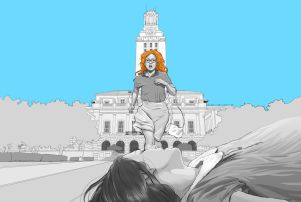
Keith Maitland says he had concerns when approaching survivors of the August 1966 mass shooting at the University of Texas about making his PBS documentary, Tower, as to how they would feel about being turned into “a cartoon.”
“When you make the decision to call somebody out of the blue and say you want to talk to them about the worst thing that has happened to you and I’m going to turn it into a cartoon … you’re bound to ruffle some feathers or turn people off,” he observed to TV critics at TCA.
Instead, he says, he got no pushback.

PBS
“I wanted to create an experiential film that was immersive. … I wanted you to feel like you were there,” Maitland said of the mass shooting carried out by Charles Whitman over about 96 minutes from the tower at the University of Texas, leaving 16 people dead. The director combined archival footage with rotoscopic animation to reframe the events of that day from the on-the-ground vantage point. PBS debuts the movie as part of its Independent Lens franchise on February 14, and the movie also made the shortlist for the Feature Documentary Oscar ahead of nominations January 24.
“We had to trust him,” Claire Wilson James says of Maitland’s project. James, who was 18 at the time of the shooting, lost the baby she was carrying after being shot through the abdomen. Her only complaint about the docu? “I wish he’d gotten my dress right.”
Things have changed little in the 50 years since, said Ramiro “Ray” Martinez, the Austin police officer who accompanied the officer credited with killing the sniper. “We still have gun violence,” though police have better learned how to deal with mass shootings at schools, he acknowledged. “Until we do something about the gun problem, we will continue to have this problem,” he said.
Asked how she feels when other mass shootings occur at schools, James said apologetically she has “felt envious” because survivors now are provided with a support system and grief experts to help them sort through their experience. That did not occur in ’66. “We had no one to talk to,” she said. “So when people say the journalists are macabre, I feel they’re just trying to tell the truth and keep it for us. I’ve seen [Maitland’s] movie 17 times, and each time I find something new I did not understand at the time, because I was right there in the middle and did not know what was going on at the time.”
Reaction of the survivors on the panel, when asked what they would say to Whitman had he been taken alive, could not have been more varied.
“I don’t think of him as a human,” said John “Artly” Fox, who was a student on campus at the time of the shooting. “To me that day he was a force of nature that could strike the campus and kill people … make death fall from a clear blue sky.”
Said James: “I would have loved to have talked to him and just try to let him know that I’m so sorry for what he went through. … I spoke to his last living relative, and she told me that at least once a week he saw his father punch his mother in the face … and that is so sad to think about. It really bothers me he was very racist, and think having been that way creates a kind of disease in you. I would love to put my arms around him and tell him somehow he doesn’t have to be that way, that he can let go of it.”
Martinez said: “I cannot answer that question. He knew he was going to die.”
EP Lois Vossen wrapped up the Q&A noting that, on the 50th anniversary of the shooting last year, Texas implemented a law permitting licensed students 21 and older to take handguns into public university classrooms, dorms and other campus buildings, as the survivors onstage shook their heads sadly.
